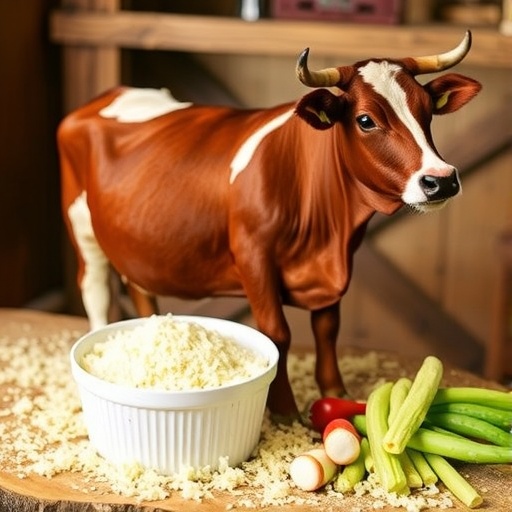In a groundbreaking study, researchers have delved deep into the nuanced world of animal nutrition, particularly focusing on the complex interactions of herbage distribution, botanical composition, and the source of rumen inoculum in the context of in vitro fermentation kinetics. As the quest for sustainable livestock production intensifies amid today’s environmental challenges, understanding these factors could have significant implications for both animal health and agricultural efficiency.
The investigation led by Nampanzira, Kiggundu, Esaete, and their colleagues employs sophisticated methodologies to quantify how variations in herbage distributions affect the fermentation processes that occur in the rumen. The study emphasizes that these fermentation processes are not merely biochemical reactions; they are influenced by a myriad of external factors, including the types of forage consumed by grazing animals and how they are distributed in a pasture. The findings promise to bridge the gap between traditional livestock feeding practices and modern nutritional requirements, providing insights that could lead to improved livestock management.
One of the critical areas explored within this research is the botanical composition of the herbage available to ruminants. Different plant species present unique carbohydrate structures that can affect the fermentation dynamics significantly. The authors demonstrate that herbage rich in specific fibers and non-structural carbohydrates tends to support more efficient fermentation, resulting in higher energy availability for the animals. Such distinctions not only influence animal performance but may also affect their overall health and resilience to diseases, an increasingly important consideration in animal husbandry.
Moreover, the inclusion of diverse botanical species in pasture management has emerged as a focal point in this study. The authors argue that not only does plant diversity enhance fermentation kinetics, but it can also improve the microbial profiles present within the rumen. A rich and varied rumen flora leads to enhanced enzymatic activity, further optimizing digestion. This discussion resonates with the ongoing dialogue within the agricultural community regarding the necessity of biodiversity in pasturing systems as a means to bolster ecological resilience.
The research also pivots towards the critical role of rumen inoculum sources. Utilizing various inoculum sources introduces different microbial populations into the rumen system, leading to distinct fermentation profiles. The scholars pinpoint that the characteristics of the inoculum can significantly influence the by-products generated during fermentation. An understanding of these microbial communities and their contributions could enable more tailored approaches to livestock feeding, promoting strategies that optimize rumen health and fermentation efficiency.
As the study unfolds, it highlights the intricate balance that must be struck between forage characteristics and microbial populations in the rumen. The adaptability of ruminants in utilizing diverse feed sources is attributed to these complex interrelationships. With precise manipulation of herbage characteristics and careful selection of rumen inoculum, livestock producers may achieve more predictable and improved fermentation outcomes, promoting higher productivity and lower emission of greenhouse gases.
An additional layer of complexity is added by the environmental conditions that can impact both herbage distribution and fermentation processes. Climatic factors such as moisture, temperature, and seasonality exert significant control over what types of forage are available and, consequently, how well these forages can be fermented. Understanding these interactions is vital as they have direct consequences on feed efficiency and animal performance. The implications of this research extend beyond animal husbandry, suggesting that better management of pasture resources could lead to more sustainable agricultural practices.
The detailed exploration of these complex dynamics sets a precedent for future research in the area. Further studies could build upon these findings, investigating the long-term effects of various herbage types and inoculum sources on both animal health and environmental sustainability. As future practices in livestock management continue to evolve, it is imperative that they are grounded in solid scientific evidence, as provided by studies such as this.
In conclusion, the research conducted by Nampanzira and colleagues serves as a vital contribution to our understanding of rumen fermentation kinetics, highlighting the importance of both herbage distribution and microbiota in optimizing livestock production. This delicate interplay not only impacts animal health but also influences broader agricultural practices. The principles emerging from this study could lead to more sustainable farming systems that prioritize both productivity and environmental stewardship, underscoring the importance of integrating scientific research with practical agricultural strategies.
As the agricultural community considers how best to respond to the challenges of the 21st century, studies like this offer hope for developing a resilient, efficient future in livestock production. Ensuring that livestock continue to play an integral role in food systems while minimizing ecological footprints will require the adoption of practices informed by research such as this, which is paving the way for innovative approaches in animal nutrition and pasture management.
Subject of Research: Impacts of herbage distribution, botanical composition, and rumen inoculum source on in vitro fermentation kinetics.
Article Title: Impacts of herbage distribution, botanical composition, and rumen inoculum source on in vitro fermentation kinetics.
Article References:
Nampanzira, D.K., Kiggundu, M., Esaete, J. et al. Impacts of herbage distribution, botanical composition, and rumen inoculum source on in vitro fermentation kinetics.
Discov Anim 2, 14 (2025). https://doi.org/10.1007/s44338-025-00049-y
Image Credits: AI Generated
DOI: 10.1007/s44338-025-00049-y
Keywords: herbage distribution, botanical composition, rumen inoculum, fermentation kinetics, livestock production, sustainability.
Tags: agricultural efficiency improvementsanimal nutritionbotanical composition in livestockenvironmental challenges in livestock farmingfermentation dynamics of plant fibersforage types and fermentationherbage distribution effectsin vitro fermentation studiesrumen fermentation kineticsruminant health and nutritionsustainable livestock productiontraditional vs modern livestock feeding





